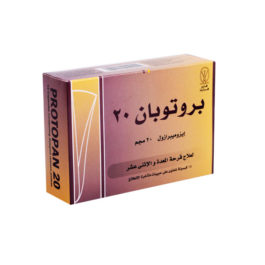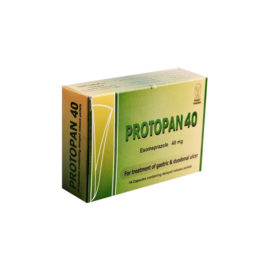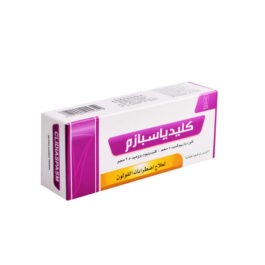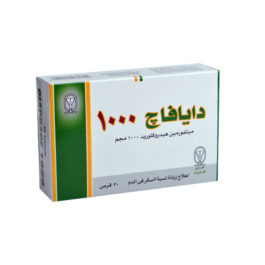Description
PHARMACOTHERAPEUTIC / INDICATION GROUP / ACTION MECHANISM:
Selective proton pump inhibitor, substituted benzimidazole.
THERAPEUTIC INDICATIONS:
− Moderate and severe reflux oesophagitis.
− In combination with two appropriate antibiotics for the eradication of H. pylori in patients with peptic ulcers with the objective of reducing the recurrence of duodenal and gastric ulcers caused by this microorganism.
− Duodenal ulcer.
− Gastric ulcer.
− Zollinger-Ellison syndrome and other pathological hypersecretory conditions.
CONTRAINDICATIONS:
Pantoprazole must not be used in case of known hypersensitivity to the active ingredient or/and any of the other constituents of Pantoprazole.
Pantoprazole, like other PPIs, should not be co-administered with atazanvir.
Pantoprazole must not be used in combination treatment for eradication of H. pylori in patient with moderate to severe hepatic or renal dysfunction.
SPECIAL WARNINGS AND PREECAUTIONS FOR USE: -Patient with severe hepatic impairment should be given 40 mg of pantoprazole every other day. In patients with severe liver impairment, the liver enzymes should be monitored regularly during treatment with pantoprazole, particularly on long-term use. In the case of a rise of the liver enzymes, the treatment should be discontinued. -In the case of combination therapy, the summaries of product characteristics of the respective medicinal products should be observed. -In the presence of any alarm symptom (e. g. significant unintentional weight loss, recurrent vomiting, dysphagia, haematemesis, anaemia or melaena) and when gastric ulcer is suspected or present, malignancy should be excluded, as treatment with pantoprazole may alleviate symptoms and delay diagnosis. -Further investigation is to be considered if symptoms persist despite adequate treatment. -In patients with Zollinger-Ellison syndrome and other pathological hypersecretory conditions requiring long-term treatment, pantoprazole, as all acid-blocking medicines, may reduce the absorption of vitamin B12 (cyanocobalamin) due to hypo- or achlorhydria. This should be considered in patients with reduced body stores or risk factors for reduced vitamin B12 absorption on long-term therapy or if respective clinical symptoms are observed. -Pantoprazole, like all proton pump inhibitors, might be expected to increase the counts of bacteria normally present in the upper gastrointestinal tract. Treatment with Pantoprazole may lead to a slightly increased risk of gastrointestinal infections caused by bacteria (e.g. Salmonella, Campylobacter, and C. difficile).
Bone fractures
Several published observational studies suggest that proton pump inhibitor (PPI) therapy may be associated with an increased risk for osteoporosis-related fractures of the hip, wrist, or spin. The risk of fracture was increased in patients who received high-dose, defined as multiple daily doses, and long-term PPI therapy (a year or longer). Patients should use the lowest dose and shortest duration of PPI therapy appropriate to the condition being treated. Patients at risk for osteoporosis-related fractures should be managed according to the established treatment guidelines.
● Prescription proton pump inhibitor (PPI) drugs may cause low serum magnesium levels (hypomagnesemia) if taken for prolonged periods of time (in most cases, longer than one year), magnesium supplementation alone did not improve low serum magnesium levels and the PPI had to be discontinued.
● Low serum magnesium levels can result in serious adverse events including muscle spasm (tetany), irregular heartbeat (arrhythmias), and convulsions (seizures); however, patients do not always have these symptoms. Treatment of hypomagnesemia generally requires magnesium supplements. Treatment in patients taking a PPI and who have hypomagnesemia may also require stopping the PPI.
PREGNANCY AND LACTATION:
Pregnancy
There are no adequate data from the use of pantoprazole in pregnant women. Pantoprazole should not be used during pregnancy unless clearly necessary.
Lactation
It is unknown whether pantoprazole is excreted in human breast milk. A decision on whether to continue/discontinue breast-feeding or to continue/discontinue therapy with Pantoprazole should be made taking into account the benefit of breast-feeding to the child and the benefit of Pantoprazole therapy to the woman.
EFFECTS ON THE ABILITY TO DRIVE AND TO USE MACHINES OR WORK WITHOUT A FIRM FOOTHOLD:
There are no known effects on the ability to drive or to operate machinery or to work without a firm foothold.
INTERACTIONS:
-Pantoprazole may reduce or increase the absorption of drugs whose bioavailability is pH-dependent (e.g. ketoconazole). Please note that this information also applies to drugs which you might have used recently.
-Pantoprazole is metabolized in the liver via the cytochrome P450 enzyme system. An interaction of pantoprazole with other drugs or compounds which are metabolized using the same enzyme system cannot be excluded. However, no clinically significant interactions were observed in specific tests with a number of such drugs or compounds, namely carbamazepine, caffeine, diazepam, diclofenac, digoxin, ethanol, glibenclamide, metoprolol, nifedipine, phenprocoumon, phenytoin, theophylline, warfarin and an oral contraceptive.
-There were also no interactions with concomitantly administered antacids.
The absorption of atazanavir is pH dependent. Therefore PPIs, including pantoprazole, should not be co-administered with atazanavir.
POSOLOGY AND METHOD OF ADMINISTRATION: Pantoprazole tablets should not be chewed or crushed, and should be swallowed whole with water 1 hour before breakfast. Recommended dosage: Adults and adolescents 12 years of age and above: Treatment of moderate and severe reflux oesophagitis One tablet of Pantoprazole per day. In individual cases the dose may be doubled (increase to 2 tablets Pantoprazole daily) especially when there has been no response to other treatment. A 4week period is usually required for the treatment of reflux oesophagitis. If this is not sufficient, healing will usually be achieved within a further 4 weeks. Adults: Eradication of H. pylori in combination with two appropriate antibiotics In Helicobacter pylori positive patients with gastric and duodenal ulcers, eradication of the germ by a combination therapy should be achieved. Depending upon the resistance pattern, the following combinations can be recommended for the eradication of H. pylori: a) twice daily one tablet Pantoprazole
+ twice daily 1000 mg amoxicillin + twice daily 500 mg clarithromycin
b) twice daily one tablet Pantoprazole + twice daily 400 – 500 mg metronidazole + twice daily 250 – 500 mg clarithromycin
c) twice daily one tablet Pantoprazole + twice daily 1000 mg amoxicillin + twice daily 400 – 500 mg metronidazole
In combination therapy for eradication of Helicobacter pylori infection, the second Pantoprazole tablet should be taken before the evening meal. The combination therapy is implemented for 7 days in general and can be prolonged to up to two weeks maximum. If, to ensure healing of the ulcers, further treatment with pantoprazole is indicated, the dosage recommendations for duodenal and gastric ulcers should be considered. Consideration should be given to official local guidance (e.g. national recommendations) regarding bacterial resistance and the appropriate use and prescription of antibacterial agents. If combination therapy is not an option, e.g. if the patient has tested negative for Helicobacter pylori, the following dosage guidelines apply for Pantoprazole monotherapy: Treatment of gastric ulcer One tablet of Pantoprazole per day. In individual cases the dose may be doubled (increase to 2 tablets daily) especially when there has been no response to other treatment. A 4week period is usually required for the treatment of gastric ulcers. If this is not sufficient, healing will usually be achieved within a further 4 weeks. Treatment of duodenal ulcer One tablet of Pantoprazole per day. In individual cases the dose may be doubled (increase to 2 tablets daily) especially when there has been no response to other treatment. A duodenal ulcer generally heals within 2 weeks. If a 2week period of treatment is not sufficient, healing will be achieved in almost all cases within a further 2 weeks. Zollinger-Ellison syndrome and other pathological hypersecretory conditions For the long-term management of Zollinger-Ellison syndrome and other pathological hypersecretory conditions patients should start their treatment with a daily dose of 80 mg (2 tablets of Pantoprazole 40 mg). Thereafter, the dosage can be titrated up or down as needed using measurements of gastric acid secretion to guide. With doses above 80 mg daily, the dose should be divided and given twice daily. A temporary increase of the dosage above 160 mg pantoprazole is possible but should not be applied longer than required for adequate acid control. Treatment duration in Zollinger-Ellison syndrome and other pathological hypersecretory conditions is not limited and should be adapted according to clinical needs.
Children below 12 years of age: Pantoprazole is not recommended for use in children below 12 years of age due to limited data in this age group.
Special populations: In patients with severe liver impairment the dose has to be reduced to 1 tablet (40 mg pantoprazole) every other day. Furthermore, in these patients the liver enzymes should be monitored during Pantoprazole therapy. In case of a rise of the liver enzymes Pantoprazole should be discontinued. The daily dose of 40 mg pantoprazole should not be exceeded in elderly patients or in those with impaired renal function. An exception is combination therapy for eradication of H. pylori, where also elderly patients should receive the usual pantoprazole dose (2×40 mg/day) during 1-week treatment.
INCORRECT USE AND OVERDOSAGE:
If you have taken too little Pantoprazole or have forgotten to take it do not take the dose late, but continue with the next regular dose on your dosing schedule.
Talk to your doctor if you want to interrupt or prematurely discontinue treatment with Pantoprazole.
There are no known symptoms of overdosage in man; in any case, the doctor must be consulted.
UNDESIRABLE EFFECTS:
The following undesirable effects have been observed with pantoprazole:
Blood and lymphatic system Very rare: Thrombocytopenia; Leukopenia
Nervous system disorders
Uncommon: Headache; Dizziness
Eye disorders
Rare: Disturbances in vision / blurred vision
Gastrointestinal Disorders
Uncommon: Diarrhoea, Nausea, vomiting, Abdominal distension and bloating, Constipation, Dry mouth, Abdominal pain and discomfort.
Skin and sub-cutaneous tissue disorders
Uncommon: Rash, exanthema, eruption, Pruritus
Rare: Urticaria, Angioedema
Musculoskeletal, connective tissue disorders
Rare: Arthralgia, Myalgia
Bone fractures.
Metabolism and nutrition disorders
Rare: Hyperlipidaemias and lipid increases, Weight changes
General disorders and administration site conditions
Uncommon: Asthenia, fatigue and malaise
Rare: Body temperature increased, Oedema peripheral
Immune system disorders
Rare: Hypersensitivity (incl. anaphylactic reactions and anaphylactic shock)
Hepatobiliary disorders
Uncommon: Liver enzymes increased (transaminases, γ-GT)
Rare: Bilirubin increased
Psychiatric disorders
Uncommon: Sleep disorders
Rare: Depression (and all aggravations)
Very rare: Disorientation (and all aggravations)
Hepatobiliary disorders
Hepatocellular injury, Jaundice, Hepatocellular failure
Psychiatric disorders
Hallucination, Confusion (especially in pre-disposed patients, as well as the aggravation of these symptoms in case of pre-existence)
Renal and urinary disorders
Interstitial nephritis
Skin and subcutaneous tissue disorders
Stevens-Johnson syndrome, Lyell syndrome; Erythema multiforme, Photosensitivity
PACKING:
A box containing 14 tablets in 2 PVDC/Al strips and a pamphlet.
STORAGE:
Keep at a temperature not exceeding 30C, in dry place.
Keep out of reach of children.








Reviews
There are no reviews yet.